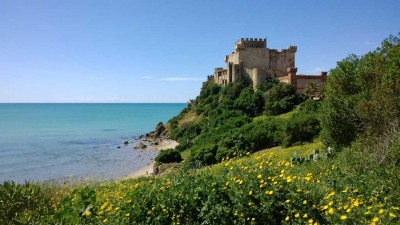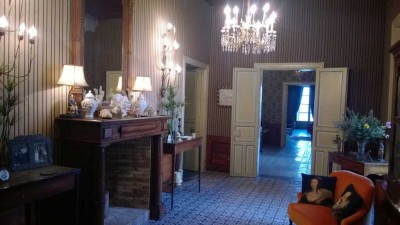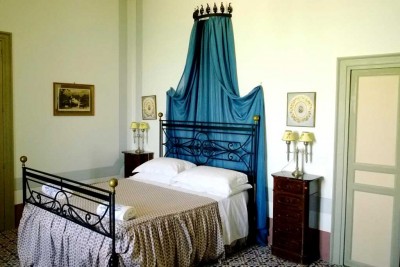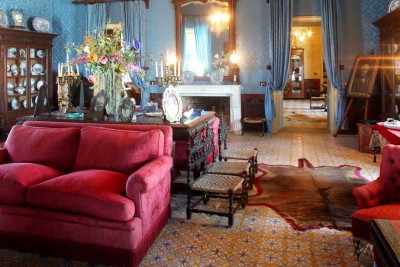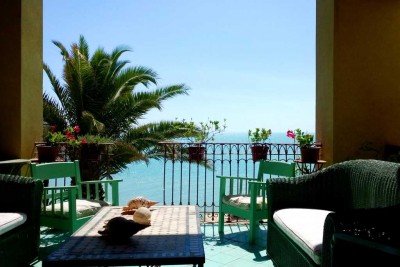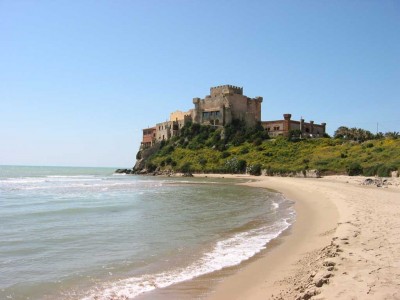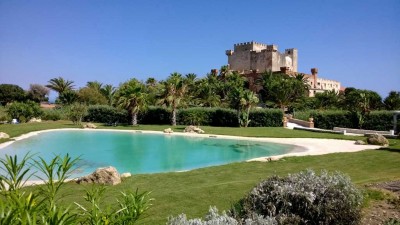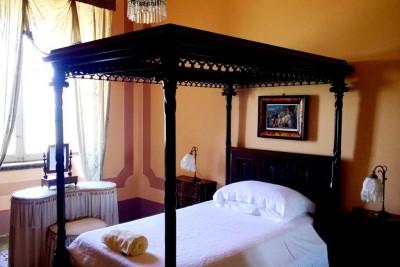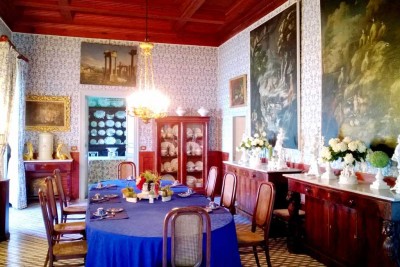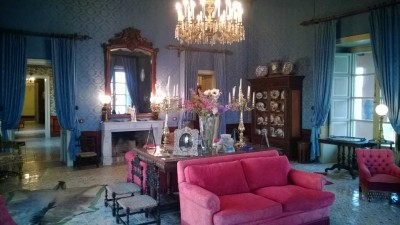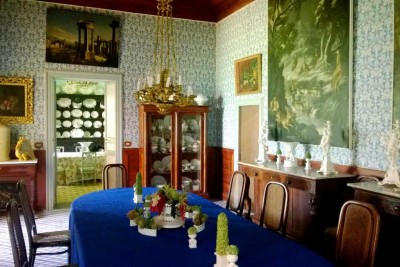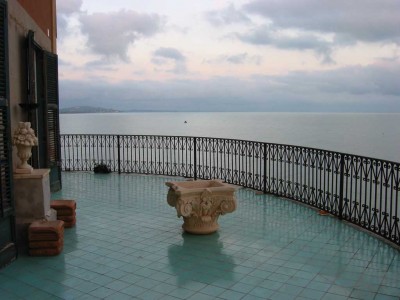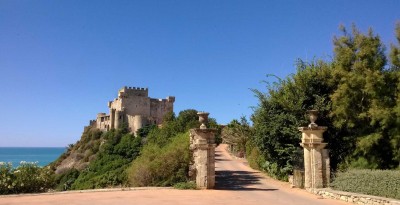Contact the abode
DATING BACK TO THE 15TH CENTURY, CASTELLO DI FALCONARA IS A UNIQUE STRUCTURE IN THE PROVINCE OF CALTANISSETTA, OFFERING A DIRECT VIEW OF THE SEA
CASTELLO DI FALCONARA: ACCOMMODATION AND WEDDINGS IN BUTERA IN SICILY
Situated on a promontory surrounded by greenery in Butera, the Castle of Falconara is the only historical residence of its kind in the province of Caltanissetta which overlooks the Mediterranean Sea. Dating back to the 15th century, it was expanded and fortified over time, maintaining its role in guarding against pirate incursions until the 18th century. The tower, the original nucleus of the Castle, served to protect a small 'loading place' and was part of the island's coastal defence system. The control of the coastline between Licata and Gela was entrusted to the towers of Falconara and Manfria, which are approximately 8 kilometres apart.
Passing from the Santapaus to the Brancifortes and finally to the Chiaramonte Bordonaro family, a new construction was added to the Castle in the mid-19th century, and it was transformed into an elegant noble residence while still preserving its ancient Aragonese structure and original spatial organisation. The original core, which consisted of the old square tower, known as the 'Falconara’ because of the falcons which the lords of the time bred and kept there over an unspecified period, was modified and expanded by different owners throughout the centuries. From a structural perspective, the Castle consists of a complex arrangement of buildings developed around the central tower. Today, it is challenging to differentiate between the various stages of its development due to the modifications and expansions that have altered its architectural characteristics.
Internally, the Castle is intricately designed, with lavishly adorned rooms that house extensive collections of ceramics, paintings, and hunting trophies earned by the master of the house and his father, Baron Gabriele Chiaramonte Bordonaro Alliata, during their numerous safaris in Kenya. The Castle is partially enclosed by a recently constructed crenellated wall. To gain entry, visitors must pass through a grand arched gate, which leads to a 'baglio' courtyard encompassing various buildings that comprise the architectural complex. The 19th-century wing, extending toward the sea, features a spacious terrace that offers sweeping views of the nearby coastline. This wing, connected to the original tower by a staircase, includes several salons and a lateral loggia. One side of the courtyard is open, and access is granted through a grand arched doorway. Surrounding the courtyard are a variety of annexes with sloping roofs, balconies and exterior-facing windows. Essentially, the complex has retained its original spatial arrangement, which is further exemplified by the presence of the valuable and finely crafted antique furniture on display.
On the elevation where the entrance is located, it is possible to observe a cannonball and two protruding corner brackets in the tower. There is also a rectangular-shaped courtyard at the entrance where the stables and warehouses are located. From the outside, one can access the family chapel, whose decorative architectural elements and main body are all made of Modica stone, while the supporting structure is composed of uniform gypsum and limestone.
Externally, Castello di Falconara is surrounded by a park whose layout was designed in 1893 by architect Ernesto Basile, who also remodelled the entrance façade to the Castle's courtyard. In addition to the lush and exotic palm grove, there is also a rare prickly pear cactus with round palm-like leaves originating from Mexico, a species which is otherwise only found in the Botanical Garden of Palermo in Sicily. A magnificent swimming pool is available for the exclusive use of guests staying at the Castle.
THE HISTORY OF CASTELLO DI FALCONARA
The precise date of the Castle's original construction remains unknown, but it is very likely that it took place in the 14th century, some time after 1313, during the War of the Vespers between the Aragonese of Sicily and the Angevins of Naples. At that time, some Angevin pirates were able to land between Gela and Licata and assault and sack Butera. The tower most certainly existed by 18 October 1392, when Martino I, with a diploma signed in Castrogiovanni, assigned it as a fiefdom with the County of Butera to Ugone Santapau, a noble Catalan family of Ademar, as a reward for his loyal support of the King against opposing factions.
The tower was already in existence in 1422, and a vice-portulan, responsible for sea-faring navigation charts and transportation, was named for the trading area of Falconara. In the first half of the 16th century, Butera became a principality, and Ambrogio Santapau became the first Prince of Butera. In 1540, the Branciforte family succeeded the Santapaus in the principality, the title passing to all their successors until it came under the onwership of Ambrogio Branciforte, who was made Prince of Butera by Philip II in 1563.
The tower was still serving its purpose of surveillance and defence against pirate raids at the end of the 18th century, when Sienese architect Tiburzio Spannocchi was commissioned by Viceroy Marcantonio Colonna (1567-1584) to design a network of observation and defensive watchtowers. His role was to provide a precise written and cartographic survey of the coastline in order to determine where the new towers were to be built, similar to the system that had been implemented in the Kingdom of Naples in 1563.
DEFENSIVE TOWERS IN SICILY
The project was finalised from 1584 by Florentine architect Camillo Camilliani, on behalf of the Deputation of the Kingdom, which was a centralised structure of the Spanish monarchy responsible for supervising all defence work and which provided for the construction of 197 towers throughout the entire island of Sicily. At this time, Camilliani noted the presence of the Falconara tower in this part of the coastline, describing it as a “very large, strong tower, built on a raised and convenient promontory, which remains very solid and secure, and is subject to the principality of Butera. The Castle is some eight miles distant from the sea and the tower is continuously guarded”.
Upon sighting the enemy, those manning the towers would immediately raise the alarm using smoke, fire or cannon shots, to signal the danger to the observation towers connected to the nearest state-owned ‘demesne’ city, known as the ‘capocomarca’. The aim was to mobilise armed militias from every inhabited centre, whether they were under feudal or state ownership. In the case of Falconara, this was the ‘com'arca’ of Piazza, which included not only the ‘demesne’ of Piazza, but also the feudal lands of Aidone, Mazzarino, Barrafranca, Pietraperzia, Terranova and Butera. The latter was required to send three knights and twenty-one infantrymen to the scene.
Falconara was therefore part of this circle of towers encircling Sicily since the 16th century, making the coastal territories defendable and secure against the sudden and devastating barbarian and Turkish incursions that plagued the Mediterranean regions from the 16th century and throughout the 18th century. It is likely that the original structure of the tower was expanded and strengthened over this period of time with walls topped with battlements, walkways, slits, bartizans and moats, bestowing upon it a commanding appearance that exuded an aura of invincibility which was visible from both land and sea, thanks to its rugged and towering cliffside position.
FROM MILITARY CASTLE TO MANSION RESIDENCE
The need for defence gradually faded as the threat of pirate raids diminished, particularly after the French conquest of Algiers in 1830 and the Mediterranean states' cooperation to combat piracy. Consequently, the decision was made to repurpose some of the military structures into stately residences. These homes served a dual purpose: they allowed for effective oversight of the estate's agricultural activities and the management of goods destined for the Castle's warehouses and wine cellars. They evolved into exclusive havens for summer leisure and relaxation. This transformation ignited a surge in architectural improvements, adorning the buildings with magnificent staircases, colonnades, friezes, capitals, pilasters, colourful faux-rustic stucco and wrought-iron balconies. Additionally, ornamental gardens featuring fountains and marble seating were designed and cultivated.
This was exactly what happened at Castello di Falconara when Princess Caterina Branciforte of Butera met and married her second husband German officer Giorgio Wilding, who served in the English navy under the command of Admiral Horatio Nelson. As this affluent and noble family sought a more dignified residence, they recognised the need for a grander estate, the existing 'manor house' no longer being in alignment with the contemporary concept of a noble residence. Consequently, they initiated the construction of an imposing south-facing wing, overlooking the sea. This new addition was connected to the pre-existing structure, which originally served as stables or a blacksmith's workshop on the ground floor, by a large staircase, covered with slabs of pitch-gray stone that tended towards turquoise, wrought-iron railings, and wooden handrails. By making some strategic modifications, including alterations to walls and partitions, they created an expansive living room, a well-appointed kitchen and a sea-view terrace. The terrace afforded panoramic vistas, spanning from Licata to Santa Croce Camerina along the coastline. The first floor below housed rooms of varying sizes, serving as living spaces and master bedrooms. On the second level, adjacent to the beach, were guest bedrooms and various service areas.
Upon her death in 1816, the Princess left Falconara to Count Wilding, who, having no children, bequeathed it to his brother Ernesto. During the uprisings of 1848, Ernesto sold the Castle and the baronial title to Antonio Chiaramonte Bordonaro, who constructed a new building next to the Castle, parallel to the sea. The ground floor of this new structure was used for productive activities such as warehouses, equipment and craft product storage, and an olive press. The first floor became the residence of the estate's tenants. Wooden coffered ceilings were created in the large salons, where his collections of 15th- and 16th-century Italian and Sicilian ceramics and majolica tiles were displayed, along with a rich art collection. Most of this art collection is now located at Villa Carlotta in Palermo, the current residence of the Chiaramonte Bordonaro family.
FACILITIES AND SERVICES: ACCOMMODATION, WEDDINGS AND PRIVATE EVENTS AT CASTELLO DI FALCONARA
The enchanting structure of Falconara Castle, positioned on a rise sloping towards the sea, is an ideal place to spend a dream vacation or celebrate weddings and other private receptions in one of the most exclusive locations in Sicily. The Castle is available for discerning travellers and those seeking a romantic getaway in an outstanding historic home.
STAYING IN A CASTLE IN SICILY
The historical residence can be rented in its entirety and is furnished with period furniture and collections of ceramics. It comprises 6 sitting rooms, 2 dining rooms, a kitchen, a utility room, 4 double bedrooms, 4 double bedrooms, and 2 single bedrooms. All bedrooms have en-suite bathrooms and sea views. The extensive seafront area, accessed directly via a staircase carved into the rock, overlooks a lush garden bordering the beach.
The guesthouse on the ground floor functions as a B&B and is composed of 1 large 82 sq m living room, a sitting room and a kitchen. It has 7 bedrooms with en-suite bathrooms and showers. An expansive terrace perched over the sea is the highlight of 3 of the 7 rooms. All rooms offer stunning sea views.
WEDDINGS AND PRIVATE EVENTS IN SICILY
The Falconara Castle Park and Tower is an exclusive venue for charming weddings and private events in Sicily. The Castle’s spacious rooms and period furnishings are guaranteed to make your wedding truly unique.
HOLIDAY HOMES BY THE SEA IN BUTERA
Within the Falconara Castle Park are 3 mini-apartments that can accommodate from 2 to 4 people each, with a living-dining room and a sofa bed, a double bedroom in a loft, two bathrooms with showers, and an external area with views of the Castle and the sea. These are considered among the most beautiful beach vacation homes in Butera in the province of Caltanissetta.
PLACES OF INTEREST IN THE VICINITY
Falconara Castle serves as a starting point for exploring eastern Sicily, including Piazza Armerina and the Villa Romana del Casale, Ragusa, Ibla, the Valley of the Temples in Agrigento, and Noto. Gourmet travellers will also be able to discover the excellent Michelin-starred restaurants located between Licata and Siracusa.
